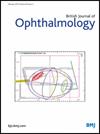青光眼视神经头Bruch膜开放形态测量术椎间盘拔罐术后结构逆转的危险因素
IF 3.5
2区 医学
Q1 OPHTHALMOLOGY
引用次数: 0
摘要
目的探讨青光眼手术后Bruch’s膜开度光学相干断层扫描(OCT)参数变化的危险因素,评价三种不同类型青光眼手术中椎间盘拔罐结构逆转的持续时间和动态。设计回顾性、干预性病例系列。方法对151例行小梁切除术、ab-间小梁切除术或青光眼引流装置(GDD)手术的患者的151只眼进行评价。评估术后Bruch膜开口最小边缘宽度(BMO-MRW)和乳头周围视网膜神经纤维层厚度的变化动态。多元线性回归模型确定了SRDC发生和严重程度的危险因素。结果与基线相比,术后随访9个月BMO-MRW显著升高(p=0.048)。所有患者的多元回归模型显示,眼压(IOP)相对降低较高(标准β= - 0.272, p<0.001),随访时间较早(标准β= - 0.280, p<0.001),手术过程中GDD(标准β=0.169, p=0.027)是SRDC的显著危险因素。在干预后的前9个月内,术后低IOP(标准β= - 0.469, p<0.001)、年轻(标准β= - 0.423, p<0.001)和较短的眼轴长度(标准β= - 0.235, p = 0.040)对BMO-MRW升高有显著影响。结论在这组接受不同类型降眼压手术的青光眼患者中,术后9个月仍有明显的SRDC。SRDC程度的危险因素是手术时年龄较小、早期低张力或术后低IOP和远视。如有合理要求,可提供资料。未识别的患者数据集可通过电子邮件向作者索取。本文章由计算机程序翻译,如有差异,请以英文原文为准。
Risk factors for postoperative structural reversal of disc cupping in Bruch membrane opening-based morphometry of the optic nerve head for glaucoma
Purpose To identify risk factors for changes in Bruch’s membrane opening-based optical coherence tomography (OCT) parameters after glaucoma surgery and to evaluate duration and dynamics of structural reversal of disc cupping (SRDC) in three different types of glaucoma surgery. Design Retrospective, interventional case series. Methods Evaluation of 151 eyes of 151 patients who received trabeculectomy, ab-interno trabeculotomy or glaucoma drainage device (GDD) surgery. Dynamics of postoperative change in Bruch membrane opening minimum rim width (BMO-MRW) and peripapillary retinal nerve fibre layer thickness in spectral-domain OCT were assessed. Multiple linear regression models identified risk factors for occurrence and magnitude of SRDC. Results Compared with baseline, BMO-MRW increased significantly up to the 9-month follow-up (p=0.048) after surgery. A multiple regression model for all patients showed a high relative reduction in intraocular pressure (IOP) (standard β=−0.272, p<0.001), an early date of follow-up ( stand β=−0.280, p<0.001) and GDD as surgical procedure (standard β=0.169, p=0.027) as significant risk factors for SRDC. Within the first 9 months after intervention, a low postoperative IOP (standard β=−0.469, p < 0.001), a young age (standard β=−0.423, p<0.001) and a short axial length (standard β=−0.235, p = 0.040) had a significant impact on the BMO-MRW increase. Conclusion In this set of patients with glaucoma undergoing different types of IOP-lowering surgery, significant SRDC was seen up to 9 months postoperatively. Risk factors for the extent of SRDC were younger age at surgery, early hypotonia or low postoperative IOP and hyperopia. Data are available upon reasonable request. Deidentified patient datasets can be requested by email from the authors.
求助全文
通过发布文献求助,成功后即可免费获取论文全文。
去求助
来源期刊
CiteScore
10.30
自引率
2.40%
发文量
213
审稿时长
3-6 weeks
期刊介绍:
The British Journal of Ophthalmology (BJO) is an international peer-reviewed journal for ophthalmologists and visual science specialists. BJO publishes clinical investigations, clinical observations, and clinically relevant laboratory investigations related to ophthalmology. It also provides major reviews and also publishes manuscripts covering regional issues in a global context.

 求助内容:
求助内容: 应助结果提醒方式:
应助结果提醒方式:


